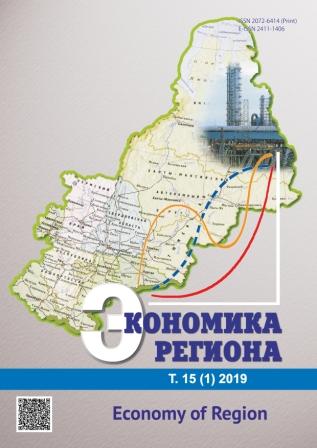Развитие кластеров на основе конкурентной специализации регионов
Cluster Development Based on Competitive Specialization of Regions
Author(s): Vladimir Kolmakov, Alexandra Grigorievna Polyakova, Svetlana Vasilievna Karpova, Alla Nikolaevna GolovinaSubject(s): Economy, National Economy, Socio-Economic Research
Published by: Институт экономики Уральского отделения Российской академии наук
Keywords: cluster;cluster development;competitive specialization;economic development;framework;industry localization;integration potential;methodic approach;spatial interaction;strategic competitiveness;
Summary/Abstract: “Bottom-up” cluster identification, as opposed to “assigning” clusters by the fact of enterprises coexisting on a compact territory, is an important scientific and practical problem. Its solution may be found in a survey of regions’ competitive specialization in order to identify spatial clusters based on industries with high-level competitive potential. The data on gross regional product (GRP) and national gross value added across industries were an empirical basis of the study. This article explores the possibility to identify territorial clusters in a region where its competitive specialization meets the high competitive potential of an industry. Research methodology stands on regional and spatial economics theories, employs traditional economic instruments of results’ verification. To achieve the expected results we employed traditional instruments of verification, economic and statistical analysis as research methodology. Studying a wide range of literature sources have resulted into development of innovative industrial approach to cluster formation by identifying clustering priorities and industries’ integration potential. The approach is based on the assessment of regions’ industrial specialization that can measure industry’s contribution to regions competitiveness, as well as density of interregional competitive relations. Such assessment is useful in determining industries potentially attractive for clustering. These industries can generate positive effect from utilizing territory’s specialization. Obvious specialization will either indicate potential’s depletion or reveal vectors for developing the most competitive industries that actually create efficient clusters. This approach contributes sufficiently to the theory and methodology of cluster paradigm of social and economic development, as it allows identifying de-facto existing clusters instead of creating them artificially. The key principle of the method is prioritizing as a cluster an industry, which is characterized by maximum productivity in social and economic spheres. Considering the competition between regions and different levels of industry development, it is possible to identify perspective directions for advancing regions strategic competitiveness. Further research will be aimed at the method’s verification and expansion by analyzing prolonged retrospective of specific data, including the gravity components of the connectedness of regions economic space and network interactions effects between the participants of “artificial” and “natural” clusters in the Russian Federation.
Journal: Экономика региона
- Issue Year: 15/2019
- Issue No: 1
- Page Range: 270-284
- Page Count: 15
- Language: Russian

